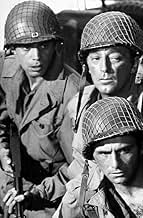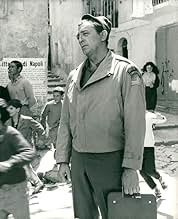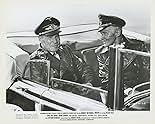Adicionar um enredo no seu idiomaA war correspondent witnesses errors of the Allied Command after he and a unit of US Army Rangers land unopposed at Anzio, Italy, but later become trapped behind German lines during one of t... Ler tudoA war correspondent witnesses errors of the Allied Command after he and a unit of US Army Rangers land unopposed at Anzio, Italy, but later become trapped behind German lines during one of the bloodiest battles of WWII.A war correspondent witnesses errors of the Allied Command after he and a unit of US Army Rangers land unopposed at Anzio, Italy, but later become trapped behind German lines during one of the bloodiest battles of WWII.
- Direção
- Roteiristas
- Artistas
Avaliações em destaque
The real battle for Anzio was a true Allied effort with the British and Americans locking in a duel to the death with the best German troops Hitler could put in Italy. It was supposed to break the deadlock of the Gustav line by flanking but was doomed from the start because it lacked sufficient landing strength. True, the road to the Rome WAS uncontested on D-Day, but Kesselring himself said later he would have easily cut off and destroyed any such small force if it extended itself even to the Alban Hills, let alone Rome.
The story of the loss of Darby's Rangers is covered in other movies better; of the 767 Rangers sent on a mission, only six returned. It is but one of many stories of horrific sacrifice of young lives. Further south, in a diversionary mission designed to take pressure off the Anzio landing, the US 36th division lost 1600 men in a single night trying to cross the Rapido river. The British took terrible losses, especially in the German offensive of 18-19 Feb 1944, mainly due to their bad luck of being placed in the line in the area in which Hitler personally chose to concentrate the main German offensive, which came within about 1000 yards of breaking the last line of defense.
Such losses are unimaginable today, yet they were accepted then as the price that must be paid to rid Europe of Hitler.
There are no films that I know of that do justice to Anzio. One would be better served by reading any of the numerous books about Anzio or even reading the write-up at http://www.army.mil/cmh/brochures/anzio/72-19.htm -- it is infinitely more interesting than this movie.
Of course the whole Anzio landing was Churchill's own idea, but to give him some credit it was an attempt to try and break the logjam of the Italian offensive. The Allies had landed back in 1943 at Salerno and Churchill's 'soft underbelly of Europe' proved to be armor plated. Progress was measured in yards. It wasn't like the trench warfare of the first World War, but it was enormous American, British, Canadian and other assorted allies casualties.
Anzio Beach was selected for a landing up the Italian coast near Rome to both outflank the Germans and maybe take Rome. It worked, but the American commander John P. Lucas moved too cautiously having remembered the 21 Day pitched battle at Salerno in those first landings in Italy. Field Marshal Kesselring was able to bring down reinforcements from the north and contain the Allies on that beach. There in fact they stayed until they linked up with the main offensive months later, just before the American Fifth Army liberated Rome officially on June 5, 1944.
The story of the military failure of Anzio is told with fictional names as Robert Ryan, Arthur Kennedy, and Arthur Franz play Mark Clark, John Lucas, and Lucian Truscott respectively. Truscott is the guy who relieved Lucas and kept the Allies from being driven off the beach, although to be fair to Lucas his priority was a secure beachhead and he certainly succeeded.
The other story of the film Anzio is that of Ernie Pyle like war correspondent Robert Mitchum who drives all the way to an unguarded Rome and then gets caught with a bunch of American GIs and one Canadian in trying to get back to Anzio beach.
Earl Holliman, Reni Santoni, and Peter Falk play some of the soldiers with Mitchum and they do well. This is definitely not a war for glory for them, they're just trying to survive out there. Falk particularly is riveting in playing an American who was wounded and invalided out of the American army from the Pacific Theater who then moved to Canada to join their army. Why you would ask, because he's grown to like it and has a real jones for combat.
Anzio unfortunately doesn't concentrate on either story long enough to tell it in the best possible way. It had potential to be a great film, but falls short. In addition Jack Jones's singing of the theme song is jarringly out of place.
What I would like is someday for someone to tell the story of the original landings in Italy at Salerno, Messina, and Brindisi. That would make a great motion picture if done right.
When you watch Anzio you are sad for the colossal waste of human life it was, especially since the objective wasn't obtained. And a great story needs better telling.
The film stars Robert Mitchum ("The Enemy Below") as Dick Ennis, a cold and cynical war correspondent that does his work on the front lines with the infantrymen. When the squad he is accompanying gets cut off behind the German lines due to an ambush, he must pick up a gun and help them fight their way back to Allied lines.
The movie has a lot going for it, right from the start. Every actor looks comfortable, especially Mitchum. Robert Mitchum has never been one of my favorite American actors, simply because he always seems to be acting despite the dimensionality of the part, Mitchum can never seem to break out of a box. Here, he looks to be having plenty of fun and seems quite natural in the role. Mark Damon ("Between Heaven and Hell") provides the necessary dramatic opposite as an infantryman who can't seem to agree with Ennis on his policies. Arthur Kennedy ("Attack and Retreat") is the exact opposite of Ennis' character as the incompetent General Lesley, who takes too much time establishing a solid beachhead and allows the Germans to launch an offensive, pinning his men down on the beach. Peter Falk ("Situation Normal, All Fouled Up"), on the other hand, is totally wasted as Corporal Rabinoff, a soldier who has become addicted to combat. Earl Holliman ("Armored Command") is the Sergeant in command of the squad, and he makes the most out of a clichéd-role by giving his character personality. Be sure to watch for Robert Ryan, Anthony Steel, Arthur Franz and Patrick Magee as Allied Generals.
There is only one big battle sequence, which expertly staged and filled with tanks, extras and big explosions. However, its effectiveness is limited because of two key flaws. Primarily, American soldiers are seen to stand up in the open and rush German machine-gun nests, only to be mowed down by overwhelming enemy fire. Secondly, there's a ridiculous scene in which Ennis and a soldier engage in a discussion about the war right in the middle of a fight, despite the fact that bullets and artillery shells are landing all around them! The final, small-scale, climactic showdown with German snipers was much more suspenseful, due to some excellent editing and great music score.
One major flaw in the film is, unfortunately, the script. It's as if "Anzio" can't decide if it wants to be a gung-ho flag-waver, or a downbeat, anti-war story. The first half the film is filled with humorous, almost slapstick scenes, although some of Mitchum's dialog hints that this is going to change and it does, in fact the focus turns around 180 degrees. Throughout the second half of the film, the action stops dead in its tracks so that the characters discuss issues of personal sacrifice, what constitutes above and beyond the call of duty, etc until it's been repeated so much that you can't stand to hear anymore. For all of this discussion, the conclusion is pretty forced. Mitchum says something along the lines of, "Men kill each other because they like to. Maybe if we all sit back and realize it, we could stop the killing and get along." That statement defines over-emphasis. Instead of being a history lesson about the real Anzio campaign, the film turns into a social commentary on Vietnam.
The on-location shooting served the proceedings well, as the film looks like sunny Italy in every frame. The scene in the Italian house looked excellent, and Dmytryk uses wide angles throughout to show off the scope of the Italian locales. The score ranges from victorious and rousing to mournful and depressing, which contributes a great deal to the mood of some important scenes such as the entry into liberated Rome and the significance of one character's death in the sniper sequence.
"Anzio" is a mixed bag, but despite a lack of focus on one theme, it manages to be entertaining and satisfying as a drama, with enough well-staged action scenes to hold it together and help obscure the muddled anti-war sentiments.
ANZIO isn't an awful film but it's far from being a great one either with the script being the major problem . It opens one of those light hearted scenes of with over paid , over sexed and over confident US soldiers that we've seen far too many times before . I guess it's supposed to be amusing but it's not . Eventually the film lives up to its title and shows us what went wrong at the Anzio landings with the American generals Clark and Lucas not driving inland quick enough . This is a fairly good history lesson since it paints a fairly poor picture of American leadership in Italy . Remember in SAVING PRIVATE RYAN , BAND OF BROTHERS and A BRIDGE TOO FAR Monty is painted as possibly the most incompetent allied General of the war ? This was nothing compared to the ridiculous mistakes made by Clark and Lucas during the Italian campaign , though somewhat cowardly this film renames Clark as " Carson " and Lucas as " Lewis " which is a great pity because a history student could do worse than watch this film , though if they did they'd notice like a great number of war films made during this period ( BATTLE OF THE BULGE is a good example ) that both German and American tanks are from a different generation but the Anzio landings here are more accurate than the ones seen in PINK FLOYD THE WALL
After this the narrative then sadly settles down into a straightforward war film where the action could basically have taken place anywhere like France or the Phillipines where a bunch of GIs are surrounded by the enemy and have to make it back to enemy lines . As many people have pointed out on these pages the script is rather unfocused and slightly disjointed and I had a gut feeling that some of it ended up on the cutting room floor , for example we see the platoon escape from a house at night and almost immediately after the platoon are trapped by some German snipers in the middle of the day , though to be honest this isn't a movie that is afraid to kill off characters so deserves some credit alongside the historical accuracy
The motion picture was partially based on real events : As Operation Shingle (January 22, 1944) was an Allied amphibious landing in the Italian Campaign against German forces in the area of Anzio, Italy. This operation was aimed at outflanking the German army on the Winter Line and as such allow for an assault on the capital city of Rome . It was one of WWIIs bloodiest battles as the Allies smash through the German lines which have enclosed the Anzio beachhead . The operation was commanded by American Major General John P. Lucas (Arthur Kennedy) and was intended to outflank German forces of the Winter Line and enable an attack on Rome. The resulting combat is commonly called the Battle of Anzio.The success of an amphibious landing at that location, in a basin consisting substantially of reclaimed marshland and surrounded by mountains, depended completely on the element of surprise and the swiftness with which the invaders could move relative to the reaction time of the defenders. Any delay could result in the occupation of the mountains by the defenders and the consequent entrapment of the invaders. Lieutenant General Mark Clark (Robert Ryan as General Carson) , commander of the U.S. Fifth Army, understood that risk, but Clark did not pass on his appreciation of the situation to his subordinate, General Lucas, who preferred to take time to entrench against an expected counterattack. The initial landing achieved complete surprise with no opposition and a jeep patrol even made it as far as the outskirts of Rome. Despite that report, Lucas, who had little confidence in the operation as planned, failed to capitalize on the element of surprise by delaying his advance until he judged his position was sufficiently consolidated and his troops ready. While Lucas consolidated, Field Marshal Albert Kesselring (Wolfgang Preiss) , the German commander in the Italian theatre, moved every spare unit to be found into a ring around the beachhead, where his gunners had a clear view of every Allied position. The Germans also stopped the drainage pumps and flooded the reclaimed marsh with salt water, planning to entrap the Allies and destroy them by epidemic. For weeks a rain of shells fell on the beach, the marsh, the harbour, and on anything else observable from the hills, with little distinction between forward and rear positions. After a month of heavy but inconclusive fighting, Lucas was relieved , sent home and replaced by Major General Lucian Truscott. The Allies finally broke out and turned his forces north-west towards Rome which was captured on 4 June. As four months and 30,000 casualties before the Allies finally march to Rome . As a result, the forces of the German Tenth Army at Cassino were able to withdraw and rejoin the rest of Kesselring's forces north of Rome, regroup, and make a fighting withdrawal to his next major prepared defensive position on the Gothic Line
Você sabia?
- CuriosidadesPeter Falk in his 2006 autobiography "Just One More Thing: Stories of My Life" stated that he didn't like the script for this film, finding it hackneyed and full of cliché; he wanted to leave the film for these reasons. However, producer Dino De Laurentiis encouraged him to stay by giving him film-poster name-above-the-title credit as well as choice of writer for his dialogue. Falk stayed on the picture and apparently actually wrote his own dialogue.
- Erros de gravaçãoToward the beginning of the film, Cpl. Jack Rabinoff (Peter Falk) is in the back of a Red Cross ambulance with three prostitutes and grabs a shoebox-sized box labeled "Hershey's Milk Chocolate Multi Pack" with a "1968 design" of the Hershey logo. One of the prostitutes reaches into the box and pulls out a "1968 design" box of Brach's Milk Chocolate Stars. In addition to the two anachronisms, Hershey's and Brach's are two separate companies.
- Citações
Dick Ennis: [attending to Rabinoff who went into sudden convulsions] Look, fellows, I think he can use the air more then the company, okay? Anything anybody can do?
Cpl. Jack Rabinoff: No, unless you have a band-aid.
Dick Ennis: Very funny.
Cpl. Jack Rabinoff: Oh, it's murder. The stomach, you see? A Japanese grenade ripped my insides. Got medal in there. Under tension it contracts and all hell breaks loose. I must have been tense.
Dick Ennis: Good thinking. You belong in a hospital, not in a war.
Cpl. Jack Rabinoff: Yeah, that's what they said when they sent me home.
Dick Ennis: You mean you got out, then you went to Canada and joined this outfit?
Cpl. Jack Rabinoff: That's right.
Dick Ennis: How did you get past the doctors?
Cpl. Jack Rabinoff: Lied about my age.
Dick Ennis: You gotta be crazy. Half your guts blown out and you're back here. What for?
Cpl. Jack Rabinoff: Awkward time for a interview.
Dick Ennis: You got something better to do? Why did you re-enlist?
Cpl. Jack Rabinoff: Why? Because I like it, you know. I missed it, Ennis. With all the mud and pain, these clowns giving orders, there's nothing like it. Look, a guy sells shoes for 40 years. I live more in one day, I see more and feel more. I taste more, I think more. I'm more, understand? I'm more. There's more to living than breathing. Capisce?
Dick Ennis: Capisce.
Cpl. Jack Rabinoff: You're the same way, that's right. War is part of you. You belong to it and when this one's over, you'll find another and I hope I'm with you.
- ConexõesReferenced in The Carol Burnett Show: Nanette Fabray and Steve Lawrence (1970)
Principais escolhas
- How long is Anzio?Fornecido pela Alexa
Detalhes
- Data de lançamento
- Países de origem
- Idiomas
- Também conhecido como
- Anzio
- Locações de filme
- Royal Palace, Caserta, Campania, Itália(opening scene)
- Empresas de produção
- Consulte mais créditos da empresa na IMDbPro
- Tempo de duração1 hora 57 minutos
- Proporção
- 2.35 : 1
Contribua para esta página






































